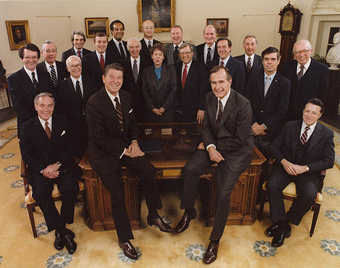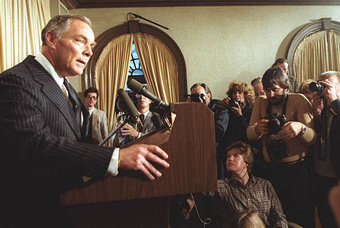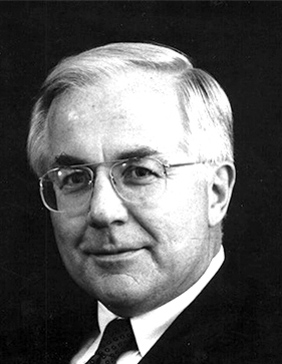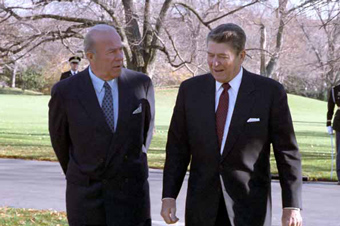The vision thing
In 1977, Richard Allen, a confidant and advisor, asked Ronald Reagan for his theory of U.S.-Soviet relations. “Here’s my strategy on the Cold War,” Reagan replied. “We win, they lose.”
This quotation reveals a crucial insight that new presidents must grasp: They must have core strategic ideas in place to orient their early policies. Of course, presidents always have to adapt to crises as they arise. But success in times of crisis often depends upon having a few clear, guiding ideas that can help presidents set their administration’s course, and navigate through the inevitable trouble.
From the word go his focus was on the cold war. To him it was a moral issue as well as a survival issue. He thought MAD [Mutually Assured Destruction] was mad. He thought it was totally immoral, that it was just an awful thing. He wanted to reduce the ability of one country to kill another, dramatically.
Reagan’s first year in office also contains three other vital lessons that he learned the hard way:
- Presidents must select advisors that are compatible with their management style;
- Presidents must have a strong, fully empowered national security advisor to facilitate effective decision making and implementation;
- Presidents must be willing to drop ineffective personnel and revisit flawed administrative arrangements early on, even when such changes can be embarrassing in a new presidency.
By the time he became president in 1981, Reagan had spent years—decades, even—formulating the key tenets of his approach to the Cold War. Like many conservatives, Reagan was alarmed by the Soviet military buildup of the 1960s and 1970s, and recent Kremlin advances in the Third World. Yet he also viewed communism as inherently unsustainable, and he perceived that Soviet military strength was cloaking profound economic, political, and ideological decay. During his prepresidential years, Reagan had thus argued that concerted pressure could turn the tide of the Cold War and restore U.S. leverage over a declining rival. That leverage, in turn, could be used to facilitate more advantageous arms control agreements and begin reducing superpower tensions on favorable terms.
Before and during the 1980 campaign, Reagan had also begun to spell out specific initiatives needed to realize this aspiration. He advocated a multiyear U.S. military buildup, along with greater efforts to resist communist expansion and contest recent Soviet gains in the Third World. He called for an economic warfare campaign against the Soviet bloc, and other initiatives to encourage Soviet dissidents and underscore the internal rot of the system. These measures, Reagan argued, were essential to restoring American strength and setting the conditions for successful East-West diplomacy. And indeed, while Reagan often appeared an unrepentant hardliner, he had long favored the reduction if not outright elimination of nuclear weapons, and he argued that Washington could safely become more aggressive in arms control once it had created a stronger negotiating position. Over the course of Reagan’s presidency, all of these ideas—from a major military buildup to dramatic disarmament proposals—would indeed become key aspects of an integrated Cold War strategy. “If you look at [his prepresidential writings and speeches],” one advisor later noted, “you can see the whole…conceptual understructure of the Reagan administration right there.”
[Ronald Reagan would] say, ‘We’ve got to build our defenses until they’re scary. Their economy is going down and it’s going to get worse.’ I’m simplifying our discussion. He watched and he fought for defense. God, he fought for defense. He cut here, he cut there for more defense. He took a lot of heat for it.
Ideas are one thing—putting them into action is another. When Reagan took office, the context for turning his “conceptual understructure” into a coherent set of policies looked promising. Democrats ruled the House, but Republicans controlled the Senate for the first time in decades. Partisanship aside, there was increased domestic and congressional receptivity to hawkish policies, largely due to Soviet overreach in recent years. And in response to that overreach, the much-maligned Carter administration had actually begun its own Cold War offensive in 1979–80, laying the initial groundwork—in areas from strategic modernization to support for anticommunist insurgents—for the policies that Reagan would pursue.
In 1981, this context—and Reagan’s overarching conceptual framework—helped the administration take several key first steps. The administration secured passage of a major defense authorization bill, initiating a multiyear buildup that would ultimately raise real defense spending by over 40 percent through 1986, and fund an array of conventional and nuclear programs. The seeds of the Reagan Doctrine were also planted, as the CIA initiated lethal support to anticommunist rebels in Nicaragua and continued Carter-era aid to the anti-Soviet jihad in Afghanistan. Reagan himself launched what would be a sustained ideological offensive against the Soviet regime, vocally declaiming its failures so as to highlight its internal weaknesses and impair its moral legitimacy at home and abroad. Finally, while measures to pressure Moscow took priority in Reagan’s first year, in November the administration began to unveil a longer-term diplomatic agenda by mooting the “zero option”—a proposal for complete prohibition of intermediate-range nuclear forces in Europe—as its political counterpart to the planned deployments of Pershing-II and Tomahawk missiles to NATO countries.
Well, there were some people who said that the whole thing was just an attempt to run the Soviet Union into bankruptcy. Actually it was not, in my view. What he needed, what we needed—and we were in full agreement on it—was to restore our military deterrent capability—to get a capability that would make it quite clear to the Soviets that they couldn’t win a war against us.
Each of these initiatives—the military buildup, the Reagan Doctrine, the ideological offensive, and the zero option—would ultimately play crucial roles in Reagan’s Cold War statecraft, and each flowed logically from the strategic mindset that Reagan brought to Washington. In this sense, Reagan’s first year affirmed the value of having core strategic ideas to catalyze and guide early action.
But despite these bold first steps, Reagan’s first year was hobbled by key institutional failings and policy deadlocks. Within the administration, “hardliners”—who favored sharp confrontation and doubted the value of diplomacy with Moscow—quarreled endlessly with “moderates”—who worried about alienating U.S. allies and favored blending strength with early negotiations—over the long-term goals and short-term tactics of Reagan’s Soviet policy. The resulting discord caused mixed messages and dueling leaks that discombobulated and often disturbed U.S. allies.
It also threw up obstacles to effective decision making on a range of key issues. Despite prolonged deliberations, the administration failed to set a position on East-West economic relations or economic warfare toward the Soviet bloc. Zero option notwithstanding, 1981 also ended without the administration forging a concrete proposal for the broader Strategic Arms Reduction Talks (START) that Reagan had proposed. Most notably of all, the administration made virtually no headway toward what should have been a crucial early objective—issuing a comprehensive strategy statement that would translate Reagan’s ideas into a formal set of priorities and actions. Certain pieces of Reagan’s policy took shape in 1981, but the overall impression was of an administration spinning its wheels.
I think almost any administration is going to be more disciplined than the Reagan administration on almost any issue, and even after the President decided, you went back at it. So it was really free flowing. In terms of U.S. foreign policy decision-making, the Reagan administration was the messiest I’ve ever seen.
In part, this disappointing debut reflected the fact that Reagan’s primary energies were actually devoted to his domestic economic program in 1981. Yet more important was the nature of his foreign-policy decision-making process. In organizing his administration, Reagan had made two crucial decisions. First, he weakened the power of the national security advisor, depriving that position of direct access to the president, and demoting it from cabinet-level to a more modest, second-tier staffing role. Second, Reagan focused less on achieving cooperation or cohesion within his inner circle than on populating the cabinet with strong-willed individuals who represented diverse opinions and who would advocate strongly for the positions and organizations they represented. Alexander Haig at State, Caspar Weinberger at Defense, William Casey at the CIA, Jeane Kirkpatrick at the U.S. permanent mission to the United Nations, and other aides all fit this mold.
These decisions had their logic. Weakening the national security advisor would ensure that no one aide dominated the inter-agency (as Henry Kissinger had done under Nixon and Ford). Likewise, Reagan’s personnel decisions would give both the hawkish and more moderate factions of the GOP stature within the administration; engender robust, multisided debates; and allow Reagan to set the basic lines of policy and then delegate implementation to strong lieutenants. It is worth noting, moreover, that this model did work in key respects. Group think was never a problem in the administration, and the mixed nature of the cabinet enabled Reagan—whose Cold War vision encompassed both confrontation and negotiation—to interact with officials who favored each of these approaches. Even in 1981, Reagan’s method of empowering trusted aides as policy entrepreneurs was also sometimes proving productive. Weinberger vigorously spearheaded the defense buildup from the Pentagon, for example, and Casey was starting to turn Reagan’s desire for a Third World offensive into the covert programs that would comprise the Reagan Doctrine. Where the administration made early progress, it often reflected the virtues of this approach.

In retrospect, however, there were also two severe liabilities of Reagan’s model, which contributed signally to the travails of 1981. The first was that Reagan’s most prominent personnel appointment, Alexander Haig, refused to work within Reagan’s intended administrative setup. Reagan wanted his lieutenants to be assertive, yet also to coexist peacefully with their colleagues, and to understand that the president ultimately set the administration’s direction. Haig was spectacularly ill-suited to this model. “CINCWORLD,” as the imposing former White House chief of staff and Supreme Allied Commander Europe was dubbed by his rivals, saw himself as a Kissinger-type figure who should overshadow all others in the administration—Reagan included—on national security. Predictably, this approach quickly poisoned the climate in Reagan’s inner circle, ensuring that the early innings were often consumed with bureaucratic turf wars rather than efforts to assemble and codify a coherent strategy.
Reagan has got to know that these people disagree with each other. People think he’s uncomfortable, he’s unwilling to resolve the argument. I don’t think he wants to resolve the argument. He doesn’t want everybody to agree. He knows they disagree. He thinks it’s just fine. He’ll tell each one to do what he wants them to do and he’s perfectly happy with that

The second liability was that the combination of a weak national security advisor (Richard Allen) and a cabinet full of strong-willed individuals was a recipe for trouble. Vigorous debate is a sign of healthy process, but without a strong manager to adjudicate disputes, force decisions, and ensure implementation, debate can turn into paralysis. This was what happened in 1981. Allen, who lacked bureaucratic stature or a close relationship with Reagan, was totally overmatched as Haig did battle with more hardline advisors—Casey, Weinberger, Kirkpatrick—across issues large and small. Intrigue and infighting were a constant; key issues from arms control to economic warfare to overall strategy languished without resolution; decisions were often relitigated internally or through the press. National Security Decision Directives (NSDD)—the administration’s guiding documents on foreign policy issues—were issued infrequently and on few important issues. The machinery of government was clogged, with Allen unable to break the jam and Reagan—who disliked personal confrontation with his subordinates—not willing to do so on his own.
“The entire first year and a half of the administration passed in an atmosphere of unremitting tension,” NSC staffer Richard Pipes later wrote. Indeed, while 1981 was not a wasted year, it was far less productive than Reagan probably hoped. The president had good and prescient ideas about Cold War strategy. But his administration was doomed to sputter so long as it lacked the supporting personnel and administrative procedures needed to turn good ideas into a comprehensive program of action.

Only as the administration learned from these shortcomings did it gradually become more effective. In mid-1982, Reagan eased Haig out of the administration, replacing him with a new secretary—George Shultz—who was far better attuned to Reagan’s strategic instincts and operating style. Earlier that year, Reagan had also accepted Allen’s resignation. He replaced him with William Clark, who possessed little substantive experience, but had a strong relationship with Reagan and a mandate to improve the policy process. Reagan also restored Clark’s position to cabinet-level status, gave Clark direct access to the president, and thereby ensured that the national security advisor could take a stronger role in coordination and implementation.
To be sure, neither these changes—nor any others—ever solved the problems of bureaucratic infighting and intrigue within the administration. But when it came to constructing and articulating a more complete Cold War strategy, the changes served their purpose. In 1982–83, Clark’s NSC staff coordinated the issuance of dozens of NSDDs on important policy issues, including two documents—NSDD-32 and NSDD-75—that provided comprehensive statements of Reagan’s strategy. In particular, NSDD-75 codified the approach that Reagan had long advocated—the idea that confrontation could ultimately enable diplomacy—and contained subordinate guidance on specific issues from Afghanistan to Central America to U.S.-China relations. At the same time, the administration finally achieved a unified position on East-West economic relations and advanced an aggressive START proposal, and Reagan used his newly empowered NSC staff to develop signature initiatives—the National Endowment for Democracy and the Strategic Defense Initiative, for example—that would play crucial roles in his Cold War statecraft.
Not least of all, despite lingering State-NSC tensions, in 1983 Shultz and NSC staffer Jack Matlock gained approval of a four-part diplomatic agenda for engaging Moscow over the long term. After a slow start, the administration was now assembling and integrating the key policies that would help alter the course of the Cold War, and ultimately facilitate the diplomatic breakthroughs that began moving that conflict toward its conclusion.

Reagan’s experience underscores the value of bringing core strategic principles to office. Whatever his other failings, Reagan had developed a perceptive and well-formed worldview during his prepresidential years, and those ideas framed what initiatives his administration did manage to roll out in 1981. The first year of any administration will be difficult and perhaps somewhat chaotic. Thinking through basic strategic concepts beforehand can help a president orient early initiatives—and recover from early mistakes.
Reagan’s experience also shows that a president must pick advisors who are compatible with his or her intended administrative style. This is not to say that advisors must agree with the president on all substantive issues; that is a recipe for sycophancy. But there must be clear understanding of how each aide will relate to the president and to the broader administration. Reagan’s unhappy experience with Haig demonstrates how a mismatch between personality and process can inject dysfunction into decision-making; future presidents would do well to avoid this mistake.
[George H. W. Bush] said, ‘Governor, do what you will, but I predict if you do select Haig, you’ll probably have problems with him.’ That was the sentence. That’s all he said and the conversation went on. All of us recall, George had him right, we didn’t—because Haig was a problem. He was a problem about appointments. He was a problem on policy. He was a problem on ego. He was not a team player.
Additionally, the Reagan years affirm the need for a strong, fully empowered national security advisor to oversee the policy process. “Oversee” does not mean “dominate,” of course, and vigorous debate is the lifeblood of smart policy. But a president still needs a strong manager to adjudicate disputes, force decisions on crucial issues, and ensure prompt and effective execution. Allen’s inability to play this role during Reagan’s first year was a major source of grief; the next administration should learn from this experience.
Finally, Reagan’s experience underscores that presidents must be willing—even at the cost of bad publicity and pundits’ heckling—to revisit flawed administrative procedures and dismiss advisors who are not fitting into the plan. It can seem costly to make such alterations early on, because any new president is understandably loath to admit unforced errors. There is also a profound loyalty that presidents feel toward their close advisors. But because so few administrations get the organizational issues entirely right the first time around, not making needed changes can be far more damaging. It was only when the Reagan administration took steps to mitigate the early internal dysfunction that its Cold War strategy really began to get on track. This willingness to learn from mistakes, and to change course accordingly, represents an important lesson for our next president.
Resources